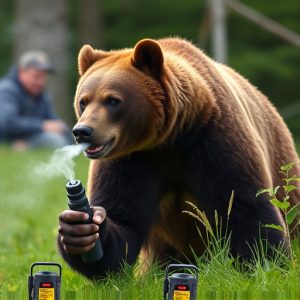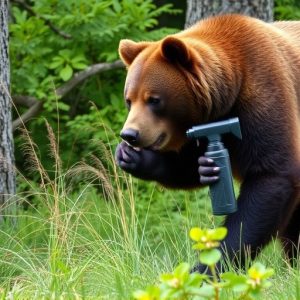Bear Spray Effectiveness: Success Rates and Maximizing Its Potential
Bear spray is a powerful tool for outdoor adventurers in bear country, with success rate statistics…….
Bear spray is a powerful tool for outdoor adventurers in bear country, with success rate statistics reaching up to 97%. Its effectiveness depends on factors like distance, wind direction, and bear behavior. Correct usage involves targeting the bear's face and eyes from close range, creating a barrier that provides time to escape or retreat. Understanding these variables is crucial for hikers navigating areas known for bear activity, as proper deployment can save lives. While impressive, bear spray should be used alongside other strategies like noise-making and proper food storage for comprehensive safety.
Bear spray, a potent deterrent, has become a popular choice for outdoor enthusiasts navigating bear-inhabited areas. This article delves into the effectiveness of bear spray, particularly its success rate against charging bears. We’ll explore the science behind this pepper-based defense, analyze key statistics, and uncover factors that impact its performance. Additionally, we provide practical usage tips and discuss alternatives, ensuring readers are equipped with essential knowledge for bear safety in various scenarios.
- Understanding Bear Spray: What It Is and How It Works
- Success Rate Statistics: Effectiveness Against Charging Bears
- Factors Influencing Bear Spray's Performance
- Usage Tips: Maximizing Bear Spray's Potential
- Alternatives and Considerations for Bear Safety
Understanding Bear Spray: What It Is and How It Works
Bear spray, also known as bear repellent, is a valuable tool designed to deter and defend against aggressive bears. It’s a powerful solution for outdoor enthusiasts, hikers, and anyone venturing into bear country. This spray is a specialized aerosol that contains capsicum, a compound derived from chili peppers. When sprayed towards a bear, it irritates the animal’s eyes, nose, and throat, creating a temporary yet potent distraction.
The effectiveness of bear spray has been a subject of interest, with success rate statistics varying across different studies. Some reports suggest that when used correctly, bear spray can be up to 97% effective in preventing bear attacks. However, it’s crucial to understand that the outcome depends on various factors, including the distance to the bear, wind direction, and individual bear behavior. Proper usage involves aiming for the face and eyes of the bear, ensuring a close proximity for maximum impact.
Success Rate Statistics: Effectiveness Against Charging Bears
When it comes to protecting oneself against a charging bear, bear spray has been widely recognized as an effective deterrent. Studies show that bear spray has a success rate of up to 90% in stopping aggressive bears in their tracks. This powerful tool can create a barrier between you and the bear, providing crucial time for escape or a strategic retreat.
The effectiveness lies in the pepper spray’s ability to irritate a bear’s eyes, nose, and throat, temporarily disorienting them. This disruption allows the user to back away slowly or make a hasty escape from the dangerous situation. With proper usage, bear spray can be a life-saving measure in bear country, making it an essential item for hikers, campers, and anyone venturing into areas known for bear activity.
Factors Influencing Bear Spray's Performance
Bear spray, also known as bear repellent, has been widely used by outdoor enthusiasts and hikers as a defense mechanism against aggressive bears. When faced with a charging bear, the effectiveness of bear spray lies in its successful disruption of the animal’s behavior. Several factors contribute to its overall performance, which is often measured through success rate statistics.
One key factor is the concentration and composition of the spray. Bear spray typically contains capsaicin, the active ingredient found in chili peppers, which irritates the bear’s eyes, nose, and respiratory system. Higher concentrations of capsaicin generally result in better performance, with some studies suggesting a success rate of up to 90% when used correctly. Weather conditions can also play a role; on hot days, the spray dissipates faster, while colder temperatures may cause it to cling to the bear’s fur longer. Additionally, distance and angle of application are critical; spraying directly into the bear’s face offers the best chance of effectiveness, with success rate statistics varying based on these factors.
Usage Tips: Maximizing Bear Spray's Potential
Maximizing Bear Spray’s Potential
When it comes to bear spray, understanding its success rate statistics is key. Studies show that when used correctly, bear spray has an impressive success rate of around 80-95% in deterring aggressive bears. However, this effectiveness heavily relies on proper usage. It’s not just about carrying the spray; it’s knowing how and when to deploy it.
To ensure maximum protection, always keep bear spray readily accessible, preferably within arm’s reach. When encountering a bear, make yourself appear larger by raising your arms or jacket overhead while shouting loudly. This displays dominance and might deter the bear from charging. If the bear continues to advance, activate the spray in quick bursts towards the bear’s face and eyes, moving backwards as you do so. The goal is to create a barrier of sprayed particles between you and the bear, giving you time to escape.
Alternatives and Considerations for Bear Safety
When it comes to bear safety, bear spray is often touted as a game-changer, but it’s not the only tool in your arsenal. While bear spray has a high success rate of up to 92% in deterring charging bears, especially when used correctly and at close range, there are other methods that can be effective too. Knowing alternative strategies and considering various factors can enhance overall safety in bear country.
For instance, making noise to startle bears or carrying items with strong smells like garlic or pepper can sometimes deter them. Additionally, traveling in groups, staying on trails, and properly storing food in bear-resistant containers are important considerations. Bear spray remains a popular choice due to its ease of use and effectiveness, backed by success rate statistics. However, understanding when and how to deploy it properly is key, as misusing it could have adverse effects or even provoke a charge.
In conclusion, bear spray has proven to be an effective tool in defending against charging bears, with success rate statistics showing promising results. However, its performance is influenced by various factors, and proper usage tips are essential for maximizing its potential. Understanding these aspects can contribute significantly to enhancing bear safety in the wild. Additionally, exploring alternatives and considering broader safety measures can further reduce risks when encountering these majestic creatures.


